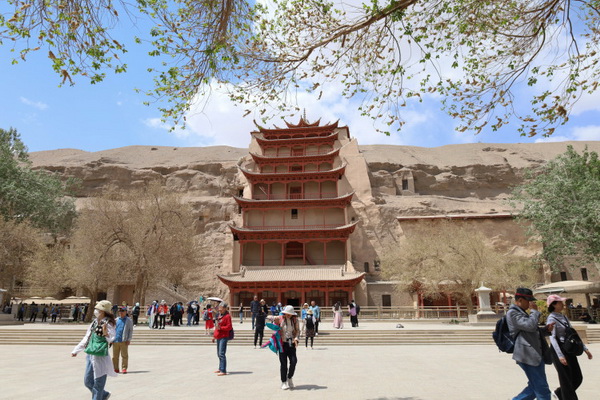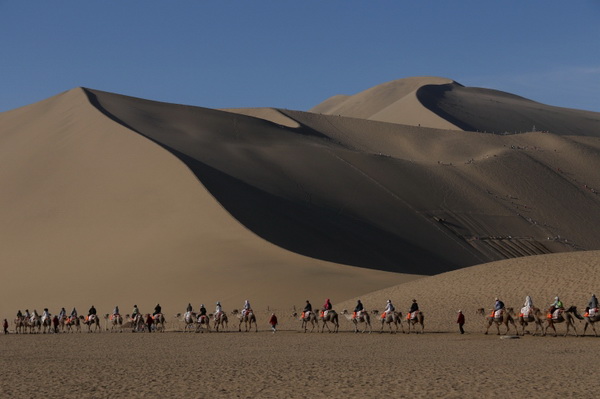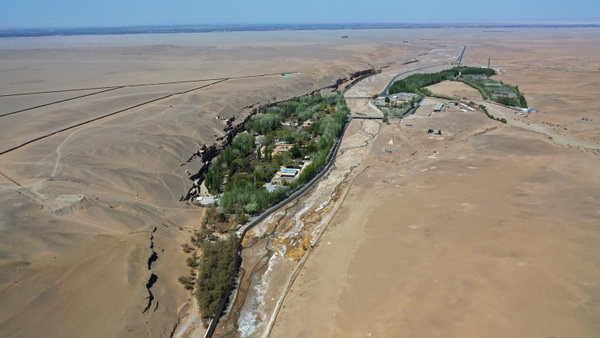

The Mogao Grottoes (Xinhua/Hu Tao, Cui Hanchao)
The Mogao Grottoes, a UNESCO World Heritage Site in northwest China's Dunhuang, has been haunted by wind and sand over a millennium, and Chinese scientists have recently unraveled the historical sand storm evolution for its better protection.
Researchers from the Northwest Institute of Eco-Environment and Resources (NIEER) under the Chinese Academy of Sciences, have successfully established the intensity sequence of dust storm activities in ancient Dunhuang, northwest China's Gansu Province, by combining historical documents with modern observation data.
"Alongside intensive efforts of the government and relics conservators in desertification control, our in-depth study into the sand storm evolution will contribute to the protection of the Mogao Grottoes and other relics in the nearby region," Liu Benli, leader of the study, told Xinhua.

Tracing sand evolution (Xinhua/Hu Tao, Cui Hanchao)
Dating back to the 4th century, the Mogao Grottoes features 735 caves carved into a cliff, currently housing more than 2,000 colorful sculptures and 45,000 square meters of murals.
Being surrounded by a vast desert, the site was once severely impacted by wind and sand.
"To prolong the life of Mogao Grottoes, generations of scientists and relics conservators have been devoted to controlling the wind and sand. Our new study sheds light on a better understanding of sand storm activities here," said Liu, also researcher at the NIEER Dunhuang Research Station of Gobi Desert Ecology and Environment.
It wasn't easy from the beginning. Although Dunhuang has ages-old Buddhist art treasures, researchers found only five records of dust storm weather with exact dates among local historical materials.
Researchers then broadened their search to collect records of dust weather events along the Hexi Corridor, which stretches over a distance of nearly 1,000 km in Gansu and is also home to five UNESCO World Heritage Sites and 53 grottoes.
They looked through weather records scattered in renowned Dunhuang manuscripts, word-inscribed bamboo slips from the Han Dynasty (202 BC-220 AD), as well as other historical records and local chronicles.
With 143 records and 83 pieces of chronological data, the study initially formed an intensity sequence of dust storm activities in Dunhuang over the past 2,000 years.
By comparing the findings with the results from several climate proxy indicators, including tree rings and ice cores in neighboring areas, researchers examined the temporal and spatial distribution of historical dust storms and their relationship with changes in climate conditions.
"Our study provides more adequate data to understand the historical climatic environment in Dunhuang and northwest China. It is of significance to the climate and environmental governance and cultural heritage protection in the region," Liu said.
"Notably, there are vast potentials and great values of historical documents. We should continue mining the existing historical records and strengthen global cooperation," he added.

Prolonging life of Mogao Grottoes (Xinhua/Hu Tao, Cui Hanchao)
Relaying and racing with time, governments and generations of Dunhuang devotees from all walks of life have been endeavoring to slow down the aging of Mogao Grottoes.
"From passive protection to active prevention, we are committed to doing everything well to prolong the life of the Mogao Grottoes," said Fan Jinshi, the honorary president of Dunhuang Academy.
The female archaeologist has made a lifelong career of protecting and studying the cultural relics of the Mogao Grottoes, and joining efforts with scientists to carry out sand-control research and practice. Efforts are made to "delay its aging."
Local governments have been dedicated to finding ways to contain the pressure of the wind and the sand toward the Mogao Grottoes, by integrated measures such as sand fixing, restoring degraded forests, and adopting modern drip irrigation technology.
Dunhuang now has a forest coverage rate of 3.54 percent and the vegetation coverage of grassland of 17.3 percent, showed statistics from the city's forestry and grassland authorities.
Scientists are contributing to sand control and relics conservation, with the in-depth study into sand, wind and their interactions with ecology as priorities.
In 2007, the NIEER Dunhuang Research Station of Gobi Desert Ecology and Environment was established as a comprehensive observation and research station focusing on desert ecological environment.
"Working days and nights in desert, we are looking for scientific methods for sand prevention and control, and cultivating younger researchers," said NIEER researcher Qu Jianjun.
"And for our dream of preserving Mogao Grottoes, too," said Qu. (Xinhua)

86-10-68597521 (day)
86-10-68597289 (night)

86-10-68511095 (day)
86-10-68512458 (night)

cas_en@cas.cn

52 Sanlihe Rd., Xicheng District,
Beijing, China (100864)

